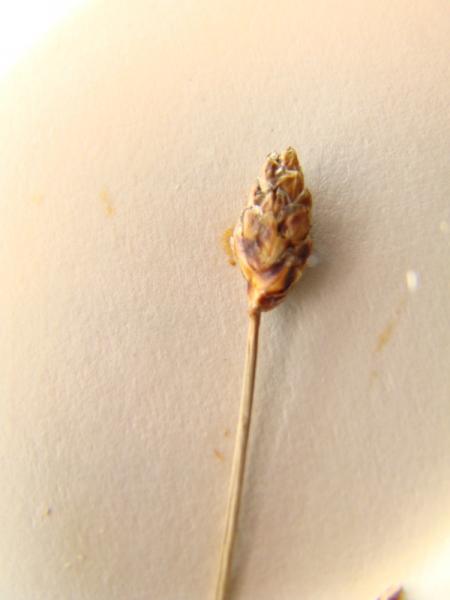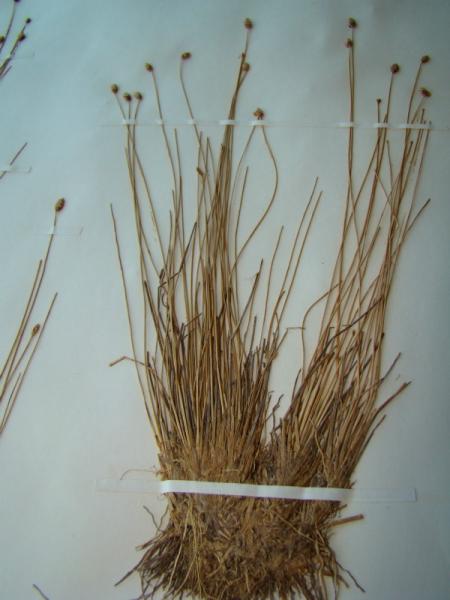Long-tubercled Spike Rush
Eleocharis tuberculosa (Michx.) Roemer & J.A. Schultes
- Class
- Monocotyledoneae (Monocots)
- Family
- Cyperaceae (Sedge Family)
- State Protection
- Threatened
Listed as Threatened by New York State: likely to become Endangered in the foreseeable future. For animals, taking, importation, transportation, or possession is prohibited, except under license or permit. For plants, removal or damage without the consent of the landowner is prohibited.
- Federal Protection
- Not Listed
- State Conservation Status Rank
- S2
Imperiled in New York - Very vulnerable to disappearing from New York due to rarity or other factors; typically 6 to 20 populations or locations in New York, very few individuals, very restricted range, few remaining acres (or miles of stream), and/or steep declines.
- Global Conservation Status Rank
- G5
Secure globally - Common in the world; widespread and abundant (but may be rare in some parts of its range).
Summary
Did you know?
The species name refers to the small projection on the top of the fruit, persistent in varying shapes on most spike-rushes. The word has the same meaning in the disease tuberculosis, which produces small nodules or tubercles in the lungs (Wikipedia contributors).
State Ranking Justification
There are eight existing populations but only two of them have more than 100 plants. Less than 50 plants have been counted in each of the remaining six populations. There are 21 populations from the late 1800s through the 1960s but nine of these, mostly from western Long Island, are considered gone because their habitat has been destroyed. The other remaining records have not been rechecked.
Short-term Trends
There is not enough information ito evaluate short-term trends. This is in part because water levels fluctuate, so follow-up surveys in subsequent years may not find plants because they are underwater.
Long-term Trends
This species has declined in the New York City, Western Long Island areas and few populations remain on the rest of Long Island.
Conservation and Management
Threats
The populations are adversely affected by pond margin development and changes in water quality.
Conservation Strategies and Management Practices
The ponds need to be protected from direct disturbance by ATVs and excessive trampling. Exotic invasive species must be prevented from colonizing the shores, and present populations of invasives should be eliminated. A natural buffer of at least 200 feet should be established around the ponds to prevent excessive runoff and pollution events.
Research Needs
Research is needed into how these populations are affected by fluctuating water levels.
Habitat
Habitat
In New York, Eleocharis tuberculosa has been found in or along the edges of coastal plain ponds and high salt marshes , usually in open habitat dominated by herbaceous vegetation (New York Natural Heritage Program 2011). Wet soil, freshwater, ponds, lakeshores, streams, meadows, pine woods, grasslands, disturbed places, bogs (FNA 2002). Sandy shores (Haines 1998).
Associated Ecological Communities
- Coastal plain pond
(guide)
The aquatic community of the permanently flooded portion of a coastal plain pond with seasonally, and annually fluctuating water levels. These are shallow, groundwater-fed ponds that occur in kettle-holes or shallow depressions in the outwash plains south of the terminal moraines of Long Island, and New England. A series of coastal plain ponds are often hydrologically connected, either by groundwater, or sometimes by surface flow in a small coastal plain stream.
- Coastal plain pond shore
(guide)
The gently sloping shore of a coastal plain pond with seasonally and annually fluctuating water levels. Plants growing on the pond shore vary with water levels. In dry years when water levels are low there is often a dense growth of annual sedges, grasses, and herbs. Submerged and floating-leaved aquatic plants, such as fragrant waterlily and pondweeds, may become "stranded" on the exposed shore. In wet years when the water level is high only a few emergents and floating-leaved aquatics may be noticeable. T
- High salt marsh
(guide)
A coastal marsh community that occurs in sheltered areas of the seacoast, in a zone extending from mean high tide up to the limit of spring tides. It is periodically flooded by spring tides and flood tides. High salt marshes typically consist of a mosaic of patches that are mostly dominated by a single graminoid species.
Associated Species
- Coreopsis rosea (pink coreopsis, pink tickseed)
- Drosera intermedia (spatulate-leaved sundew)
- Eleocharis flavescens var. olivacea (Torr.) Gleason
- Gratiola aurea (golden hedge-hyssop)
- Proserpinaca pectinata (comb-leaved mermaid-weed)
- Psilocaria scirpoides
- Scleria reticularis (netted nut sedge)
Range
New York State Distribution
This spikerush is currently known only from Suffolk County on Long Island with historical records west through Queens and Staten Island north to Westchester County.
Global Distribution
This spikerush occurs along the Atlantic coastal plain from New Hampshire to central Florida. It extends west through the Southeast United States from Virginia to Tennessee, Arkansas, Louisiana, and extreme southeastern Texas. Its northeastern limit is reached in western Maine and northern New Hampshire.
Identification Comments
General Description
Spikerushes consist of a simple stem (the leaves bladeless and inconspicuous), with the infloresence a solitary, many-scaled spikelet at the top of the stem. The perianth (sepals and petals), if present, is reduced to bristles. The base of the style is expanded into a tubercle, and is usually persistent on the fruit (achenes). Long-tubercled Spikerush is a perennial species which forms dense clumps. The stems are elliptical or circular with rounded ridges, and the leaf sheaths are persistent, straw-colored or green and often with minute red spots. The spikelets are egg-shaped, 5 to 15 millimeters long and 1.5 to 2 mm wide. There are 5 to 6 bright brown perianth bristles, as long or shorter than the achenes. The achenes are brown, angled, 0.9 to 1.7 mm long, and each face has 8 to 10 with 8 to 10 depressions in each vertical row. The tubercles are at least as tall and wide as the achene, with a rounded tipl (FNA 2002).
Best Life Stage for Proper Identification
Individuals with mature fruit are best for identification.
Similar Species
Eleocharis tortilis, a species considered extirpated in New York, is closely related to E. tuberculosa. It differs from E. tuberculosa by having tubercles shorter or narrower than the achenes, and acutely trigonous culms (FNA 2002).
Best Time to See
Fruits are present from July through mid-October.
- Fruiting
The time of year you would expect to find Long-tubercled Spike Rush fruiting in New York.
Long-tubercled Spike Rush Images
Taxonomy
Long-tubercled Spike Rush
Eleocharis tuberculosa (Michx.) Roemer & J.A. Schultes
- Kingdom Plantae
- Phylum Anthophyta
- Class Monocotyledoneae
(Monocots)
- Order Cyperales
- Family Cyperaceae (Sedge Family)
- Order Cyperales
- Class Monocotyledoneae
(Monocots)
- Phylum Anthophyta
Additional Common Names
- Spikerush
Additional Resources
Best Identification Reference
Flora of North America Editorial Committee. 2002. Flora of North America, North of Mexico. Volume 23. Magnoliophyta: Commelinidae (in part): Cyperaceae. Oxford University Press, New York. 608 pp.
Other References
Fernald, M. L. 1950. Gray's manual of botany. 8th edition. Corrected printing (1970). D. Van Nostrand Company, New York. 1632 pp.
Gleason, Henry A. and A. Cronquist. 1991. Manual of Vascular Plants of Northeastern United States and Adjacent Canada. The New York Botanical Garden, Bronx, New York. 910 pp.
Haines, A. and T.F. Vining. 1998. Flora of Maine, A Manual for Identification of Native and Naturalized Vascular Plants of Maine. V.F.Thomas Co., Bar Harbor, Maine.
Holmgren, Noel. 1998. The Illustrated Companion to Gleason and Cronquist's Manual. Illustrations of the Vascular Plants of Northeastern United States and Adjacent Canada. The New York Botanical Garden, Bronx, New York.
New York Natural Heritage Program. 2010. Biotics database. New York Natural Heritage Program. New York State Department of Environmental Conservation. Albany, NY.
New York Natural Heritage Program. 2024. New York Natural Heritage Program Databases. Albany, NY.
Weldy, T. and D. Werier. 2010. New York flora atlas. [S.M. Landry, K.N. Campbell, and L.D. Mabe (original application development), Florida Center for Community Design and Research http://www.fccdr.usf.edu/. University of South Florida http://www.usf.edu/]. New York Flora Association http://newyork.plantatlas.usf.edu/, Albany, New York
Links
About This Guide
This guide was authored by: Stephen M. Young and Richard M. Ring
Information for this guide was last updated on: January 23, 2012
Please cite this page as:
New York Natural Heritage Program. 2024.
Online Conservation Guide for
Eleocharis tuberculosa.
Available from: https://guides.nynhp.org/long-tubercled-spike-rush/.
Accessed July 27, 2024.

